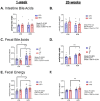This is a preprint.
Aerobic capacity and exercise mediate protection against hepatic steatosis via enhanced bile acid metabolism
- PMID: 39484384
- PMCID: PMC11526936
- DOI: 10.1101/2024.10.21.619494
Aerobic capacity and exercise mediate protection against hepatic steatosis via enhanced bile acid metabolism
Update in
-
Aerobic Capacity and Exercise Mediate Protection Against Hepatic Steatosis via Enhanced Bile Acid Metabolism.Function (Oxf). 2025 May 19;6(3):zqaf019. doi: 10.1093/function/zqaf019. Function (Oxf). 2025. PMID: 40194946 Free PMC article.
Abstract
High cardiorespiratory fitness and exercise show evidence of altering bile acid (BA) metabolism and are known to protect or treat diet-induced hepatic steatosis, respectively. Here, we tested the hypothesis that high intrinsic aerobic capacity and exercise both increase hepatic BA synthesis measured by the incorporation of 2H2O. We also leveraged mice with inducible liver-specific deletion of Cyp7a1 (LCyp7a1KO), which encodes the rate-limiting enzyme for BA synthesis, to test if exercise-induced BA synthesis is critical for exercise to reduce hepatic steatosis. The synthesis of hepatic BA, cholesterol, and de novo lipogenesis was measured in rats bred for either high (HCR) vs. low (LCR) aerobic capacity consuming acute and chronic high-fat diets. HCR rats had increased synthesis of cholesterol and certain BA species in the liver compared to LCR rats. We also found that chronic exercise with voluntary wheel running (VWR) (4 weeks) increased newly synthesized BAs of specific species in male C57BL/6J mice compared to sedentary mice. Loss of Cyp7a1 resulted in fewer new BAs and increased liver triglycerides compared to controls after a 10-week high-fat diet. Additionally, exercise via VWR for 4 weeks effectively reduced hepatic triglycerides in the high-fat diet-fed control male and female mice as expected; however, exercise in LCyp7a1KO mice did not lower liver triglycerides in either sex. These results show that aerobic capacity and exercise increase hepatic BA metabolism, which may be critical for combatting hepatic steatosis.
Keywords: Cyp7a1; cholesterol synthesis; de novo lipogenesis; liver; metabolism; non-alcoholic fatty liver disease.
Figures






References
-
- Younossi Z., Anstee Q.M., Marietti M., Hardy T., Henry L., Eslam M., et al., 2018. Global burden of NAFLD and NASH: trends, predictions, risk factors and prevention. Nature Reviews Gastroenterology & Hepatology 15(1):11–20. - PubMed
-
- Church T.S., Kuk J.L., Ross R., Priest E.L., Biltoff E., Blair S.N., 2006. Association of cardiorespiratory fitness, body mass index, and waist circumference to nonalcoholic fatty liver disease. Gastroenterology 130(7):2023–2030. - PubMed
Publication types
Grants and funding
LinkOut - more resources
Full Text Sources
